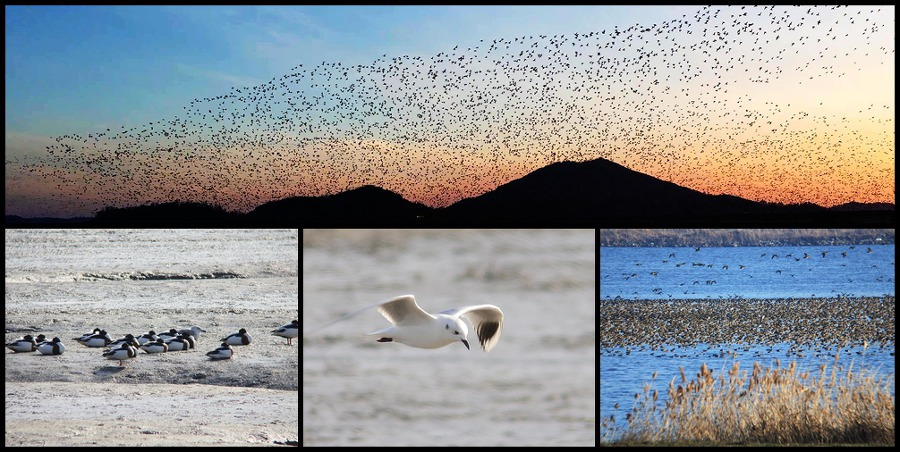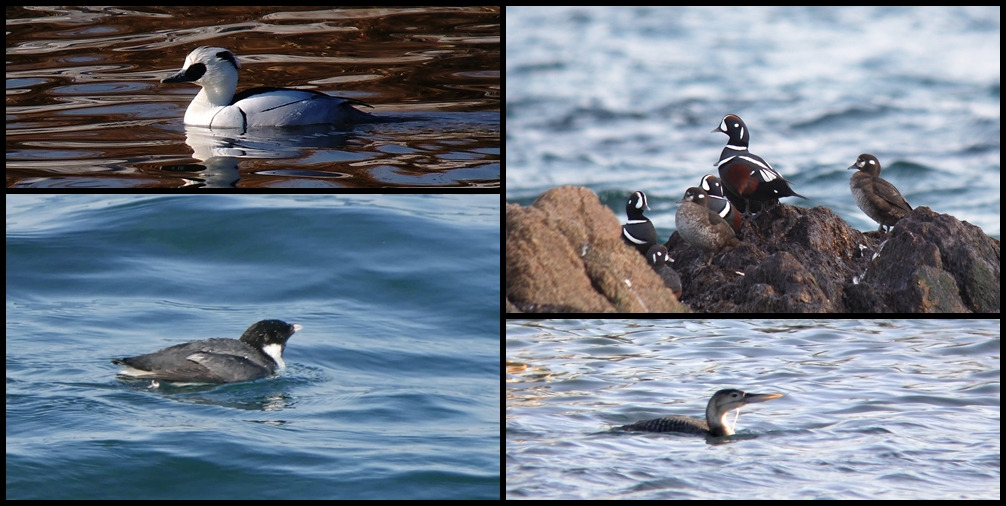Core Winter Birding Trip for Far East Asian Endemics (10 day winter birding tour)

● Seoul - Han river - Cheorwon - East Coast - Seosan - Geum river - Suncheon Bay - Upo wetland -Ganghwa Island - Seoul
● Birding site : Mudflat, Rice filed, Wetland, Coast & Forest
● How far from Seoul : 30~450km
● How to bird : driving & walking Main Target : Swan Goose, Tundra Bean Goose, Falcated Teal, Baikal Teal, Mandarin Duck, Scaly-sided Merganser, Oriental Stork, Temminck's Cormorant, Saunders's Gull, Ancient Murrelet, Pacific Loon, White-tailed Eagle, Steller's Sea Eagle, Cinereous Vulture, Eastern Buzzard, White-naped Crane, Hooded Crane, Red-crowned Crane, Pygmy Woodpecker, Bull-headed Shrike, Pallas's Rosefinch, Varied Tit, Brown Dipper, Naumann's Thrush, Japanese Wagtail, Yellow-billed Grosbeak, Pallas's Bunting
● Target Family : Geese, Ducks, Cranes, Raptors, Woodpeckers, Thrushes, Robins, Finches, Bunting, Crows
● Good Season : November ~ mid-March
* This Trip is designed for 10 day, but you can ask us to extend or reduce.
Target birds list
--------------------------------------
Swan Goose
Greater White-fronted Goose
Taiga Bean-Goose
Tundra Bean-Goose
Whooper Swan
Ruddy Shelduck
Common Shelduck
Mandarin Duck
Baikal Teal
Northern Shoveler
Gadwall
Falcated Duck
Eurasian Wigeon
Eastern Spot-billed Duck
Mallard
Northern Pintail
Green-winged Teal
Common Pochard
Tufted Duck
Greater Scaup
Harlequin Duck
Black Scoter
Common Goldeneye
Smew
Common Merganser
Red-breasted Merganser
Scaly-sided Merganser
Ring-necked Pheasant
Horned Grebe
Red-necked Grebe
Little Grebe
Great Crested Grebe
Eared Grebe
Oriental Turtle-Dove
Eurasian Coot
Sandhill Crane
White-naped Crane
Common Crane
Hooded Crane
Red-crowned Crane
Eurasian Curlew
Northern Lapwing
Sanderling
Common Snipe
Common Sandpiper
Green Sandpiper
Common Murre
Spectacled Guillemot
Ancient Murrelet
Mew Gull
Saunders's Gull
Black-headed Gull
Black-tailed Gull
Herring Gull
Slaty-backed Gull
Glaucous Gull
Red-throated Loon
Arctic Loon
Pacific Loon
Pelagic Cormorant
Great Cormorant
Gray Heron
Great Egret
Little Egret
Oriental Stork
Eurasian Spoonbill
Cinereous Vulture
Hen Harrier
Northern Goshawk
White-tailed Eagle
Steller's Sea-Eagle
Eastern Buzzard
Upland Buzzard
Eurasian Eagle-Owl
Long-eared Owl
Gray-capped Woodpecker
Pygmy Woodpecker
White-backed Woodpecker
Great Spotted Woodpecker
Gray-headed Woodpecker
Eurasian Kestrel
Bull-headed Shrike
Chinese Great Grey Shrike
Eurasian Jay
Azure-winged Magpie
Oriental Magpie
Rook
Daurian Jackdaw
Carrion Crow
Large-billed Crow
Bohemian Waxwing
Coal Tit
Varied Tit
Marsh Tit
Great Tit
Chinese Penduline-Tit
Eurasian Skylark
Brown-eared Bulbul
Long-tailed Tit
Vinous-throated Parrotbill
Japanese White-eye
Goldcrest
Eurasian Wren
Brown Dipper
White-cheeked Starling
Eurasian Nuthatch
Naumann's Thrush
Dusky Thrush
Daurian Redstart
Siberian Accentor
Blue Rock-Thrush
Eurasian Tree Sparrow
Japanese Wagtail
White Wagtail
Brambling
Hawfinch
Yellow-billed Grosbeak
Long-tailed Rosefinch
Oriental Greenfinch
Yellow-throated Bunting
Pallas's Bunting
Reed Bunting
Rustic Bunting
<< Tour Outline >>
- This trip is designed to focus on Far East Asia Endemics in winter.
- This Trip starts and ends in Seoul.
- An experienced leader will guide you through all the schedules.
- This trip will cover the most of the famous wintering habitats in South Korea.
- The schedule can be reduced or increased under the agreement.
- Included in the cost : Accommodation(9 nights), all meals, bottled water, transportation, all park entrance fees, and the services of local guides and leaders.
- Not included : insurance, drinks, tips, and items of a personal nature.
<< Itinerary >>
Day 1 : Hwaseong Lake & Seosan Cheonsu Bay
In the morning, you will encounter Eurasian curlews, some shorebirds and waterfowl at the Hwaseong Lake Wetlands. Cheonsu-Bay is the most attractive birdwatching site for wintering birds. It's located on the west coast of Chungcheong province. The biggest rice fields are filled with hundreds of thousands of geese and ducks. Oriental Stork, Eurasian Spoonbill and many kinds of raptors can also be found here.

Day 2 : Geum River Estuary
One of the top 5 birding sites in Korea. We will focus on Baikal teals in this area. They form huge groups in Korea in winter-over 500,000 at times. If we are lucky, we can see one of the greatest spectacles in the avian world.

Day 3 : Suncheon Bay
Suncheon Bay is famous for well-preserved mudflat ecosystem. It is the largest wintering location of Hooded Cranes in Korea. More than 3000 of them were recorded in late last winter. The Suncheon tidal flats are the largest wintering ground for the Saunders' Gulls, and they can be seen there.

Day 4 : Junam Reservior
Junam Reservoir, a reservoir measuring approximately 1.8 million pyeong (approximately 6.5 million square meters) in Changwon City, is a migratory bird sanctuary. With vast swamps, islands filled with reeds, and an abundance of food, it offers a natural haven for migratory birds. From November to March, cranes, black-faced spoonbills, and geese spend the winter here. It is the third largest wintering ground for cranes in Korea.

Day 5 : Upo Wetland
Upo Wetland is the largest natural wetland in Korea, and is a famous winter habitat for migrating birds where you can enjoy beautiful scenery. Crested Ibis was restored in Upo and released in spring 2019.

Day 6-7 : Taebaek Mountain and East Coast
Enjoy the snowy scenery while searching for Asian rosefinches on Taebaeksan Mountain. If you're lucky, you might spot a brown dipper in the valley.
The east coast becomes special in winter. Lagoons and Coast lines are crowded with many wintering birds, making for beautiful scenery. The environment is quite different from the west coast, so the birds are different. We can see many kinds of raptors, gulls, scoters, ducks, swans and murrelets.

Day 8 : Han River Upstream ~ Cheorwon
In the morning, you'll fly east from Seoul, observing Steller's sea eagles and Scaly-sided Merganser in the upper reaches of the Han River. You'll birdwatch at the wetland park near Paldang Dam, focusing on a variety of waterfowl, woodpeckers, and buntings.
In the late afternoon, you'll travel two hours to Cheorwon, ending your first day by watching the cranes return to their roosts at sunset.

Day 9 : Cheorwon
At dawn, you'll witness cranes waking up on the ice of the reservoir, along with tens of thousands of geese flying in unison. As you explore the Cheorwon Plains, you'll look for two or three more species of cranes, in addition to the red-crowned crane and white-naped crane. You'll also have the opportunity to see various birds of prey. After seeing enough cranes, the tour concludes in the late afternoon with a search for cranes near the Paju DMZ.

Day 10 : Imjin River and Han River Estuary
Visit the largest vulture site in northern South Korea, visit the Imjin and Han River estuaries to spot swan geese, and observe birds like buntings, finches, robins, titmice, and shrikes in the forests and rice paddies near the DMZ, where human access is limited.

<< Additional Information >>
- When you submit your booking request, we will give you a notice about a deposit to fix the schedule.
- If you have any questions, please e-mail us at birding.kr@gmail.com.
- If you are travelling alone, You can go on a tour by matching yourself with other participants.
- If you would like a longer tour to see more birding hot spots, you can add locations in the south parts of the peninsua like Nakdong estuary, Junam reservior, Dongnim reservoir and Jeju island.
- If you would like a shorter tour to fit your schedule, you can ask us.
- If you would like to book accommodation in Seoul before or after your trip, we can include it in your tour.
'Birding Tours > Winter Tours' 카테고리의 다른 글
| [Winter] Crane Trip (0) | 2024.12.02 |
|---|---|
| [Winter] Intensive Winter Birding Trip in South Korea (5 day) (0) | 2019.11.12 |
| [Winter] Ocean birds Trip (0) | 2019.08.13 |
| [Winter] Winter Birding Tours Overview (0) | 2019.04.22 |
| [Winter] Baikal Teals Trip (0) | 2017.09.21 |
